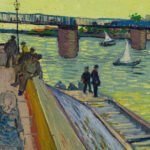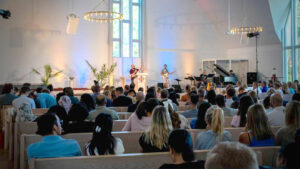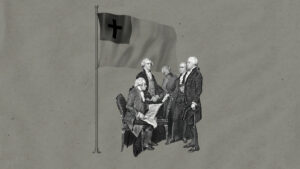The events of Holy Week happened. Really.
A few years back I immersed myself in a book project synthesizing the four Gospel accounts of the life, death, and resurrection of Jesus into a single narrative. I wrote a lot about the time between Palm Sunday and Resurrection Sunday. I felt it then, and I continue to be moved now by how many pages of Scripture are devoted to that eight-day span. There is no other place like it in Scripture—so many words devoted to so brief a window of time.
Scripture is given to reveal God, not to conceal him. I’ve examined the details of the Good Friday narratives to try to piece together a timeline of events on that holy and horrible day. Other scholars’ timelines bear minor differences from mine—which is part of the reality of trying to reconstruct a particular timestamp from an era that didn’t concern itself with the minute hand as much as our does. Still, I take great encouragement from the fact that our variations exist because we are dealing with an actual event that could have only happened one way.
You could put these events in your calendar or set them as reminders to sound throughout the day. Times are approximate.
That said, here’s a timeline of the events as they possibly unfolded on that first Good Friday, with corresponding Scripture references. You could put these events in your calendar or set them as reminders to sound throughout the day. Times are approximate.
4:00 to 6:00 a.m.
Jesus’s trial before Annas and Caiaphas.
(Matthew 26:57–68; Mark 14:53-65; Luke 22:66–70; John 18:12–28)
6:00 to 8:00 a.m.
Jesus’s trial before Pontius Pilate and Herod. Jesus appears before Pilate, is sent over to Herod, and then back to Pilate where he is sentenced to be crucified.
(Matthew 27:1–26; Mark 15:1–15; Luke 23:1–25; John 18:28–19:16)
8:00 to 8:30 a.m.
Jesus carries his cross, with Simon of Cyrene’s help, to Golgotha.
(Matthew 27:27–32; Mark 15:16–22; Luke 23:26–33; John 19:16–17)
9:00 a.m. (Crucifixion)
Jesus is crucified: “It was the third hour” (Mark 15:25). For the Jewish people, the first hour of the day was 6:00 a.m.
(Matthew 27:35; Luke 23:33; John 19:18–22)
9:00 to 9:30 a.m.
The soldiers divide Jesus’s clothing. He prays for them.
(Matthew 27:35; Mark 15:24; Luke 23:34; John 19:23–24)
9:30 to 11:00 a.m.
The soldiers watch over the crucifixion and mock Jesus: “He can’t save himself. Come down from there, Son of God.”
(Matthew 27:36–43; Mark 15:29–32; Luke 23:35–38)
11:00 a.m. to Noon
Jesus speaks from the cross to the thieves on either side. The repentant thief asks Jesus to remember him, and Jesus promises, “Today you will be with me in paradise.” And to his mother, Mary, and to John, Jesus says, “Woman, here is your son. . . . John, here is your mother.’”
(Matthew 27:38–44; Luke 23:39–43; John 19:25–27)
Noon
A three-hour darkness descends upon the land: “When the sixth hour had come, there was a darkness over the whole land until the ninth hour.”
(Matthew 27:45; Mark 15:33)
Noon to 3:00 p.m.
The earth quakes, the temple curtain is torn, and Jesus thirsts.
(Matthew 27:51–54; Mark 15:38; Luke 23:45; Matthew 27:46–50; Mark 15:33–37; Luke 23:35–38; John 19:29)
3:00 p.m.
Jesus dies: “At the ninth hour, Jesus cried out, ‘My God, My God, why have you forsaken me?’” “Jesus said, ‘It is finished,’ and he gave up his spirit.”
(Matthew 27:46; Mark 15:34–39; Luke 23:46; John 19:30)
************
After this, before night set in, the soldiers thrust a spear into Jesus side to make sure he was dead. They then permitted Joseph of Arimathea to take down Jesus’s body and bury him in a nearby grave.
They sealed the grave with a large round stone built to roll like a giant wheel into place, covering the mouth of the tomb.
Everyone expected he would remain in that tomb, because that’s what happens with those who are dead and buried. They stay dead and they stay buried.
Editors’ note: For a fuller look at the first Holy Week, see Russ Ramsey’s Behold the King of Glory: A Narrative of the Life, Death, and Resurrection of Jesus Christ (Crossway, 2015), as well as Andreas Köstenberger and Justin Taylor’s The Final Days of Jesus: The Most Important Week of the Most Important Person Who Ever Lived (Crossway, 2014). The above timeline reflects one possible breakdown of the events as they unfolded on the first Good Friday, based on this author’s best synthesis of the four Gospel accounts.
Download your free Christmas playlist by TGC editor Brett McCracken!
 It’s that time of year, when the world falls in love—with Christmas music! If you’re ready to immerse yourself in the sounds of the season, we’ve got a brand-new playlist for you. The Gospel Coalition’s free 2025 Christmas playlist is full of joyful, festive, and nostalgic songs to help you celebrate the sweetness of this sacred season.
It’s that time of year, when the world falls in love—with Christmas music! If you’re ready to immerse yourself in the sounds of the season, we’ve got a brand-new playlist for you. The Gospel Coalition’s free 2025 Christmas playlist is full of joyful, festive, and nostalgic songs to help you celebrate the sweetness of this sacred season.
The 75 songs on this playlist are all recordings from at least 20 years ago—most of them from further back in the 1950s and 1960s. Each song has been thoughtfully selected by TGC Arts & Culture Editor Brett McCracken to cultivate a fun but meaningful mix of vintage Christmas vibes.
To start listening to this free resource, simply click below to receive your link to the private playlist on Spotify or Apple Music.


































